Best of the Rest
So, we’ve looked at both vertical and horizontal shmups. What’s left? Plenty, my friend! The Genesis has quite a few games that fit the genre though they don’t scroll in either of the two traditional directions. Many of these use a pseudo-3D engine or scroll every which way left from Sunday. For that reason, we’re giving them a category all their own!
The 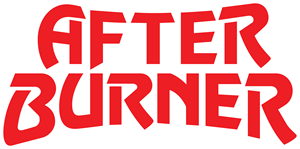 Series
Series
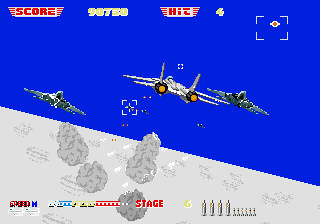 The After Burner games have been on every single Genesis console since the Master system, but Genesis fans were lucky to get all three games. Be it the original for the 32X, the sequel for the Genesis itself, or part three on the Sega CD’ there’s enough arcade action here to satisfy any arcade buff. I personally prefer the 32X After Burner, but both the other games are great as well, even though After Burner III comes up just short of its cartridge siblings. Pretty strange that, given that it should possibly have been the best of the bunch, having the advantage of the Sega CD’s hardware scaling and rotation. That version has an excellent soundtrack though, second in the series only to the remixed tracks on the Sega Ages collection released on the Saturn by Working Designs. Every Genesis fan should have these games in their library; they’re just that much fun. Read our reviews of Afterburner Complete and Afterburner III.
The After Burner games have been on every single Genesis console since the Master system, but Genesis fans were lucky to get all three games. Be it the original for the 32X, the sequel for the Genesis itself, or part three on the Sega CD’ there’s enough arcade action here to satisfy any arcade buff. I personally prefer the 32X After Burner, but both the other games are great as well, even though After Burner III comes up just short of its cartridge siblings. Pretty strange that, given that it should possibly have been the best of the bunch, having the advantage of the Sega CD’s hardware scaling and rotation. That version has an excellent soundtrack though, second in the series only to the remixed tracks on the Sega Ages collection released on the Saturn by Working Designs. Every Genesis fan should have these games in their library; they’re just that much fun. Read our reviews of Afterburner Complete and Afterburner III.
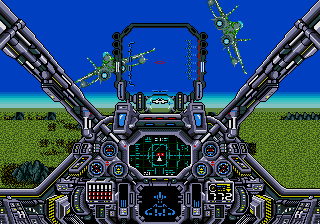 As one of only four games released by the now-defunct publisher Seismic, Air Diver rounds out their trilogy of shmups by filling in the “other” category (M.U.S.H.A. is a vertishmup and Hellfire a horishmup). It’s very much in the same vein as the Afterburner series but has you also fighting extraterrestrials instead of just enemy jets. Hmm, a terrorist organization that has the backing of several unfriendly alien governments? And we thought Bin Laden was bad! Air Diver‘s unique premise makes for some interesting combat, and I found it interesting to discover how the F-119D stealth fighter can hold its own against alien technology. Though not big on graphics, the game does do a good job of emulating the speed of flying a high-speed craft, and it features something that Sega’s jet games lack: boss battles. Taking on big mother ships with your missiles and vulcan cannon may not seem like much of a contest, but never underestimate stealth technology! Maybe this has something to do with all those rumors of it being based on stuff found at Roswell…
As one of only four games released by the now-defunct publisher Seismic, Air Diver rounds out their trilogy of shmups by filling in the “other” category (M.U.S.H.A. is a vertishmup and Hellfire a horishmup). It’s very much in the same vein as the Afterburner series but has you also fighting extraterrestrials instead of just enemy jets. Hmm, a terrorist organization that has the backing of several unfriendly alien governments? And we thought Bin Laden was bad! Air Diver‘s unique premise makes for some interesting combat, and I found it interesting to discover how the F-119D stealth fighter can hold its own against alien technology. Though not big on graphics, the game does do a good job of emulating the speed of flying a high-speed craft, and it features something that Sega’s jet games lack: boss battles. Taking on big mother ships with your missiles and vulcan cannon may not seem like much of a contest, but never underestimate stealth technology! Maybe this has something to do with all those rumors of it being based on stuff found at Roswell…
The  Series
Series
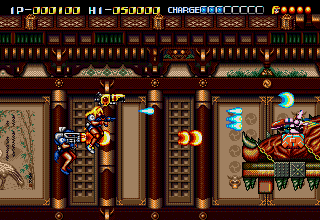 One of the biggest travesties of the Genesis era was the failure to localize Battlemania 2. The original came stateside thanks to the good folks at Vic Tokai under the title Trouble Shooter and even with its horrible artwork (how horrible? Check it out here), it’s still one of my favorites. You take control of a pair of hired guns called Crystal and Madison and set off to rescue Prince Eldon, who has been kidnapped by the evil weapons genius Blackball. The story is hilarious, and the humor never lets up, even during boss battles (Trouble Shooter’s stage one boss blows kisses before he strikes!). Cut scenes are merely a convenient stage for some of the corny gags and comments that you’ll either groan or roll with laughter at. The gameplay is Forgotten Worlds but differs in that you control both Madison and Crystal simultaneously. The game is mostly a horizontal scroller but does move vertically in some cases and the need to use Crystal to shoot behind you is constant.
One of the biggest travesties of the Genesis era was the failure to localize Battlemania 2. The original came stateside thanks to the good folks at Vic Tokai under the title Trouble Shooter and even with its horrible artwork (how horrible? Check it out here), it’s still one of my favorites. You take control of a pair of hired guns called Crystal and Madison and set off to rescue Prince Eldon, who has been kidnapped by the evil weapons genius Blackball. The story is hilarious, and the humor never lets up, even during boss battles (Trouble Shooter’s stage one boss blows kisses before he strikes!). Cut scenes are merely a convenient stage for some of the corny gags and comments that you’ll either groan or roll with laughter at. The gameplay is Forgotten Worlds but differs in that you control both Madison and Crystal simultaneously. The game is mostly a horizontal scroller but does move vertically in some cases and the need to use Crystal to shoot behind you is constant.
Battlemania 2, or Trouble Shooter Vintage as it’s sometimes called, never came to the U.S. and that’s a shame. It goes far beyond the original in so many ways and is really where the series hit its stride. The graphics are amazing (all that parallax!) and the bosses are huge. Gameplay remains mostly intact from the original, but the weapons are even more destructive now. Probably the most expensive of the “Forgotten Five” after Panorama Cotton, this is one of those games that is actually worth its price.
 What’s the best way to describe Burning Force? Simple. Space Harrier on a bike, at half the speed. Everything here seems influenced by Sega’s classic coin-op, only Namco didn’t have the energy to copy the most important aspect of Harrier: the speed and excitement of fast, twitch gameplay. Burning Force plods along, seemingly taking forever to get to the end of a stage, and sometimes the action is slow enough to put you to sleep. The cool warping effect and decent weapons system might be enough to nudge you awake, but you’ll zonk out again as soon as you get to a boss battle. The worse part about this is that the game is quite long and feels like it goes on forever at some points. Adding to the mediocrity is a great soundtrack that is overshadowed by some bad sound effects. I know that arcade ports were usually off the mark back in those days, but this could have been much better.
What’s the best way to describe Burning Force? Simple. Space Harrier on a bike, at half the speed. Everything here seems influenced by Sega’s classic coin-op, only Namco didn’t have the energy to copy the most important aspect of Harrier: the speed and excitement of fast, twitch gameplay. Burning Force plods along, seemingly taking forever to get to the end of a stage, and sometimes the action is slow enough to put you to sleep. The cool warping effect and decent weapons system might be enough to nudge you awake, but you’ll zonk out again as soon as you get to a boss battle. The worse part about this is that the game is quite long and feels like it goes on forever at some points. Adding to the mediocrity is a great soundtrack that is overshadowed by some bad sound effects. I know that arcade ports were usually off the mark back in those days, but this could have been much better.
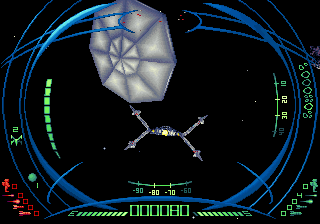 Too little, too late. That would perhaps be the best way to sum up Frontier Developments Ltd.’s Darxide. Available only in Europe, it was the last game to be released there for the 32X (penultimate overall, behind Spider-Man: Web of Fire) before the system was discontinued as part of Sega’s mad scheme to kill off everything to focus on the Saturn (and we all know how well that went). Essentially, Darxide is a modern take on the arcade classic Asteroids. An alien race has displaced an asteroid field, and this is wreaking havoc on the solar system and its miner inhabitants. As the only craft available, you must battle through twelve “levels” to protect the planets of the system from the drifting space rocks, as well as from opposing alien craft. Each of the so-called “levels” themselves are merely your approach to the next planet in the solar system, all of which are crawling with asteroids and alien baddies.
Too little, too late. That would perhaps be the best way to sum up Frontier Developments Ltd.’s Darxide. Available only in Europe, it was the last game to be released there for the 32X (penultimate overall, behind Spider-Man: Web of Fire) before the system was discontinued as part of Sega’s mad scheme to kill off everything to focus on the Saturn (and we all know how well that went). Essentially, Darxide is a modern take on the arcade classic Asteroids. An alien race has displaced an asteroid field, and this is wreaking havoc on the solar system and its miner inhabitants. As the only craft available, you must battle through twelve “levels” to protect the planets of the system from the drifting space rocks, as well as from opposing alien craft. Each of the so-called “levels” themselves are merely your approach to the next planet in the solar system, all of which are crawling with asteroids and alien baddies.
It kills me to look at Darxide and know that Sega let this game stay in Europe. If ever there was a title to show off the 32X’s capabilities and sell systems, this was it. It’s the one of the only 32X titles to use texture mapping (I’ve read that Doom and Metal Head use it as well), and actually looks better than some early Saturn games. Interestingly enough, Frontier has brought Darxide back for Microsoft Mobile Pocket PCs and Nokia’s Series 60 Smartphone in a newly enhanced version entitled Darxide EMP. You do better to get one of those versions, since a complete 32X copy will run you more than the phone itself (some auctions on eBay have reached as high as $300).
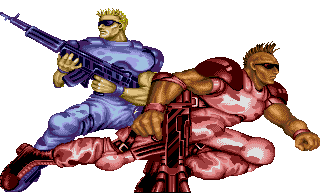 Capcom has quite a few shmups in their catalog and allowed Sega to release one of their better efforts for the Genesis’ debut. Forgotten Worlds puts you in the role of either of the “Nameless Ones” and sends you out across several levels of intense action that sometimes scroll vertically and even diagonally. Along the way you collect Zenny coins for each kill that can be used purchase weapons and items in the store, which springs up at the beginning of each level. A second player can come along for the ride, making this one a good choice for some multi-player shmupping. The graphics are quite good and the game plays surprisingly well with the Genesis pad (A rotates counter-clockwise and B rotates clockwise), especially the very comfortable six-button pad.
Capcom has quite a few shmups in their catalog and allowed Sega to release one of their better efforts for the Genesis’ debut. Forgotten Worlds puts you in the role of either of the “Nameless Ones” and sends you out across several levels of intense action that sometimes scroll vertically and even diagonally. Along the way you collect Zenny coins for each kill that can be used purchase weapons and items in the store, which springs up at the beginning of each level. A second player can come along for the ride, making this one a good choice for some multi-player shmupping. The graphics are quite good and the game plays surprisingly well with the Genesis pad (A rotates counter-clockwise and B rotates clockwise), especially the very comfortable six-button pad.
FACT: Forgotten Worlds was also released for the Turbo Duo. It featured better graphics, all the levels from the arcade, and a great soundtrack but lacked the two-player option and suffered from horrible gameplay with the stock Duo pad. Nec Avenue remedied this by releasing an excellent controller for it in Japan, but U.S. gamers were once again left out in the cold.
I personally prefer the Genesis version, as the gameplay is much better, and the two-player option maintains more of the arcade original’s feel. Not convinced? Read our review and decide for yourself.
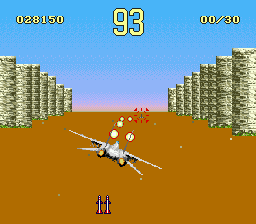 If you think that G-LOC Air Battle is anything like Sega’s other jet fighter classic Afterburner, you’re only half right. Unlike that arcade monster, G-LOC focuses more on single objectives than it does on rip-roaring speed and adrenalin. You’ll be tasked with everything shooting down a specific number of enemy planes to taking out ground forces in canyons. You’ll even find yourself having to land your plane on the aircraft carrier deck! There are different changes in viewpoint, which livens things up a bit (and it’s done much better than the horrible Afterburner III), but the game is much slower than you’d expect, and while the action is solid, it does get repetitive after a while. Nonetheless, Afterburner fans still looking for some more Tomcat fun should definitely check out G-LOC, at least to see how the concept can be taken in a different direction that’s still fun.
If you think that G-LOC Air Battle is anything like Sega’s other jet fighter classic Afterburner, you’re only half right. Unlike that arcade monster, G-LOC focuses more on single objectives than it does on rip-roaring speed and adrenalin. You’ll be tasked with everything shooting down a specific number of enemy planes to taking out ground forces in canyons. You’ll even find yourself having to land your plane on the aircraft carrier deck! There are different changes in viewpoint, which livens things up a bit (and it’s done much better than the horrible Afterburner III), but the game is much slower than you’d expect, and while the action is solid, it does get repetitive after a while. Nonetheless, Afterburner fans still looking for some more Tomcat fun should definitely check out G-LOC, at least to see how the concept can be taken in a different direction that’s still fun.
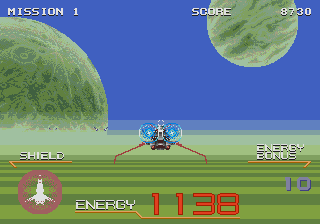 This is perhaps my biggest disappointment on the Genesis. Of all the games that were ported from the arcades, Galaxy Force II was the one to which I was most looking forward. I knew that the Genesis could in no way reproduce the fantastic rotation of Sega’s fantastic Y board coin-op, I at least hoped that the actual gameplay and graphics would make the transition intact. Unfortunately, there is severe sprite flickering and some slowdown, both of which are bad enough to affect gameplay in certain areas. The more I go back and play this, hoping my memory is worse than the reality, the more apparent it becomes that this was a game made for the Sega CD, which could have handled it without much trouble. The Y board is the same used for Power Drift, another arcade classic that had Sega CD written all over it. Ironically enough, Sega chose to let that one come out on PC-Engine HuCard (!) and Galaxy Force got stuck with a rather small cartridge. One of the first of Sega’s many blunders with their CD add-on, as both of these games could have helped to sell systems.
This is perhaps my biggest disappointment on the Genesis. Of all the games that were ported from the arcades, Galaxy Force II was the one to which I was most looking forward. I knew that the Genesis could in no way reproduce the fantastic rotation of Sega’s fantastic Y board coin-op, I at least hoped that the actual gameplay and graphics would make the transition intact. Unfortunately, there is severe sprite flickering and some slowdown, both of which are bad enough to affect gameplay in certain areas. The more I go back and play this, hoping my memory is worse than the reality, the more apparent it becomes that this was a game made for the Sega CD, which could have handled it without much trouble. The Y board is the same used for Power Drift, another arcade classic that had Sega CD written all over it. Ironically enough, Sega chose to let that one come out on PC-Engine HuCard (!) and Galaxy Force got stuck with a rather small cartridge. One of the first of Sega’s many blunders with their CD add-on, as both of these games could have helped to sell systems.
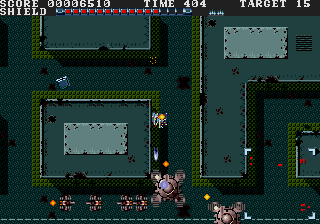 Renovation was always one of the premier third-party companies for the Genesis and they released more titles than just about anyone, save for Electronic Arts and Sega themselves. Among their huge line of contributions was Granada, which still causes controversy to this day. Is it or isn’t a shmup? I feel that it is, since you are piloting a ship while you take out enemies everywhere. The style is different from your standard shmup, but the concept is still the same. You’re placed into a level with no real path to follow, just and objective: kill everything. Two primary and five secondary weapons (depending on the stage) give you all the firepower you need to accomplish your mission. There aren’t that many stages but given the sheer size of them all, you’ll take more time to reach the boss than you would think. While it may not be much to look at graphically, Granada isn’t ugly by any stretch of the imagination. It’s one of those games that has that “early Genesis” feel (take that as you will).
Renovation was always one of the premier third-party companies for the Genesis and they released more titles than just about anyone, save for Electronic Arts and Sega themselves. Among their huge line of contributions was Granada, which still causes controversy to this day. Is it or isn’t a shmup? I feel that it is, since you are piloting a ship while you take out enemies everywhere. The style is different from your standard shmup, but the concept is still the same. You’re placed into a level with no real path to follow, just and objective: kill everything. Two primary and five secondary weapons (depending on the stage) give you all the firepower you need to accomplish your mission. There aren’t that many stages but given the sheer size of them all, you’ll take more time to reach the boss than you would think. While it may not be much to look at graphically, Granada isn’t ugly by any stretch of the imagination. It’s one of those games that has that “early Genesis” feel (take that as you will).
FACT: Granada is often mistakenly referred to as Granada “X” due to the style of the logo.
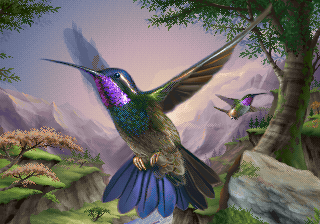 Very odd, but very original, Kolibri is the type of game that tries to break the established conventions of a genre by injecting some originality into the gameplay, while innovating graphically. You play one mean little hummingbird charged with saving the environment from a dark crystal that is destroying everything. Leave it to developer Novatrade (of Ecco the Dolphin fame) to go way beyond what you’d expect from a shmup. It may seem weird to use a laser-wielding, bomb-dropping, little bird against a slew of insects and other animal nasties, but it’s actually a lot of fun. The game looks absolutely gorgeous, with some of the most colorful backgrounds you’ll see on either the Genesis or 32X. As with Ecco, the presentation tries to be peaceful, something odd for a shmup. There’s no emphasis on hectic action here; exploration is instead the focus of each level, and sometimes it can be a bit hard to even find your way through to the end of the level.
Very odd, but very original, Kolibri is the type of game that tries to break the established conventions of a genre by injecting some originality into the gameplay, while innovating graphically. You play one mean little hummingbird charged with saving the environment from a dark crystal that is destroying everything. Leave it to developer Novatrade (of Ecco the Dolphin fame) to go way beyond what you’d expect from a shmup. It may seem weird to use a laser-wielding, bomb-dropping, little bird against a slew of insects and other animal nasties, but it’s actually a lot of fun. The game looks absolutely gorgeous, with some of the most colorful backgrounds you’ll see on either the Genesis or 32X. As with Ecco, the presentation tries to be peaceful, something odd for a shmup. There’s no emphasis on hectic action here; exploration is instead the focus of each level, and sometimes it can be a bit hard to even find your way through to the end of the level.
Not your typical shmup, Kolibri deserves a look, regardless. Yet another good reason for shmup fans to think about getting a 32X.
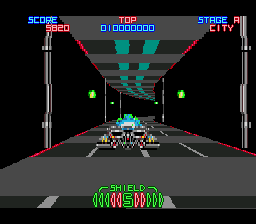 Yet another great Sega CD games left to rot in Japan due to Sega’s insane belief that the natural evolution was FMV games (ask Digital Pictures how that turned out), Night Striker is a game that seems to be made for the system. Taking the classic forward-scrolling gameplay of Super Thunder Blade and Galaxy Force II and using the Sega CD’s hardware scaling features, it plays much smoother than those games, and looks great. You play through six levels out of a possible nine (think of a Darius-style set up), which makes it highly replayable…and playing it is very simple. The entire game is already in English, and all you need is to pick up the controller and get going. Shoot and dodge are the only instructions you’ll need to jump right in. I found Night Striker to be somewhat influenced by Space Harrier in regard to enemies and bosses, which isn’t a bad thing at all, and I get a little sad when I think that it, along with so many others, weren’t brought to the U.S. The Sega CD really could have benefited from more games like it. You can always import though, or go for the Saturn version, which both looks better and is easier to play on a U.S. system.
Yet another great Sega CD games left to rot in Japan due to Sega’s insane belief that the natural evolution was FMV games (ask Digital Pictures how that turned out), Night Striker is a game that seems to be made for the system. Taking the classic forward-scrolling gameplay of Super Thunder Blade and Galaxy Force II and using the Sega CD’s hardware scaling features, it plays much smoother than those games, and looks great. You play through six levels out of a possible nine (think of a Darius-style set up), which makes it highly replayable…and playing it is very simple. The entire game is already in English, and all you need is to pick up the controller and get going. Shoot and dodge are the only instructions you’ll need to jump right in. I found Night Striker to be somewhat influenced by Space Harrier in regard to enemies and bosses, which isn’t a bad thing at all, and I get a little sad when I think that it, along with so many others, weren’t brought to the U.S. The Sega CD really could have benefited from more games like it. You can always import though, or go for the Saturn version, which both looks better and is easier to play on a U.S. system.
Success created a game that pushed the Genesis to its limits, testing its sprite scaling capabilities more than most any other game. Sunsoft published it and only made around 5,000 copies. The game, Panorama Cotton is the series’ only entry on the console and it commands upwards of $100 on eBay, making it the most expensive of the “Forgotten Five” and one of the priciest games on the system. I scored my copy for $150 and love it, as the game does everything Space Harrier 2 did, only in much grander fashion. It’s long and deep, with plenty to come back to once you’re done.
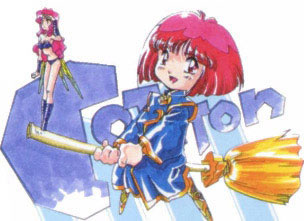 The magic upgrade system allows for some awesome attacks, giving you some excellent offensive options. I think our review says it best: Enemies release little floating scrolls that are what give you your magic attacks. Each color represents a different magic, and you can change the type of magic in each scroll by shooting them before you take them. You need to fly close to them or they’ll zip right past you. That presents an interesting challenge as you’re also shooting enemies and avoiding oncoming fire.
The magic upgrade system allows for some awesome attacks, giving you some excellent offensive options. I think our review says it best: Enemies release little floating scrolls that are what give you your magic attacks. Each color represents a different magic, and you can change the type of magic in each scroll by shooting them before you take them. You need to fly close to them or they’ll zip right past you. That presents an interesting challenge as you’re also shooting enemies and avoiding oncoming fire.
As you rack up kills, an experience meter fills up. Each time it fills, your magic goes up a level, giving it a longer range and making it more potent. Also, collecting little star orbs can increase your total life bar, which is indispensable for getting through the long stages.
I recommend you find yourself a copy and see just why Panorama Cotton is so revered. You may want to try it out first (hint, hint), but I’m sure you’ll agree that it’s worth having in your library.
FACT: Upon release, Success gave away a limited-edition teacup (see it here) as a promotional item during the ETCS Show back in 1995. Don’t expect to find that teacup though, as it’s practically non-existent nowadays.
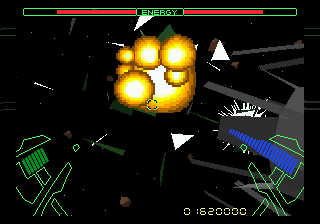 I don’t care what anyone says. I personally liked Shadow Squadron more than Star Wars Arcade. It brought back memories of playing Star Raiders on the Atari 2600, and any game that can do that deserves a place in this guide. Known as Stellar Assault in Europe, Shadow Squadron is a fun little shmup that plays better than the aforementioned LucasArts title. It’s best when used with the 6-button controller, with a total of five used for different commands. There are several objectives that must be completed to pass each stage, and this is where Shadow Squadron shines. You can choose auto pilot and concentrate on blowing things up or take a friend and let him fly while you blast everything in sight! Not as hard as Star Wars Arcade, it can be beaten fairly quickly, but is fun enough to come back to. It’s inexpensive, enjoyable, and good with a pal. Hey, you need every reason you can find for owning a 32X. Here’s one more.
I don’t care what anyone says. I personally liked Shadow Squadron more than Star Wars Arcade. It brought back memories of playing Star Raiders on the Atari 2600, and any game that can do that deserves a place in this guide. Known as Stellar Assault in Europe, Shadow Squadron is a fun little shmup that plays better than the aforementioned LucasArts title. It’s best when used with the 6-button controller, with a total of five used for different commands. There are several objectives that must be completed to pass each stage, and this is where Shadow Squadron shines. You can choose auto pilot and concentrate on blowing things up or take a friend and let him fly while you blast everything in sight! Not as hard as Star Wars Arcade, it can be beaten fairly quickly, but is fun enough to come back to. It’s inexpensive, enjoyable, and good with a pal. Hey, you need every reason you can find for owning a 32X. Here’s one more.
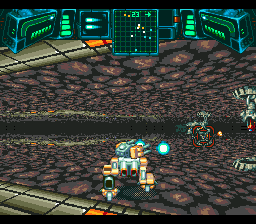 Soul Star is one of my favorite Sega CD games, and one of Core’s best efforts overall, I think. It is the epitome of everything a Sega CD shmup should be, in terms of presentation. Some amazing scaling and rotation show off what the system can do, and the soundtrack is absolutely incredible. Now, all this goodness has to have a price, right? Well, yes and no. If anything can be mentioned, it would have to be the game’s insane difficulty level. Soul Star can be brutally hard, sometimes practically cheap. This is due to the steep learning curve of its gameplay. I recommend you have a six-button pad, as playing Soul Star with the stock pad is nigh impossible. Those with zen-like patience and a mean streak should have no trouble, but the rest of us are in for a really hard time. As one of the few shmups that have no codes, no debugs, no hidden easter eggs or anything; it is truly a man’s shmup.
Soul Star is one of my favorite Sega CD games, and one of Core’s best efforts overall, I think. It is the epitome of everything a Sega CD shmup should be, in terms of presentation. Some amazing scaling and rotation show off what the system can do, and the soundtrack is absolutely incredible. Now, all this goodness has to have a price, right? Well, yes and no. If anything can be mentioned, it would have to be the game’s insane difficulty level. Soul Star can be brutally hard, sometimes practically cheap. This is due to the steep learning curve of its gameplay. I recommend you have a six-button pad, as playing Soul Star with the stock pad is nigh impossible. Those with zen-like patience and a mean streak should have no trouble, but the rest of us are in for a really hard time. As one of the few shmups that have no codes, no debugs, no hidden easter eggs or anything; it is truly a man’s shmup.
The  Series
Series
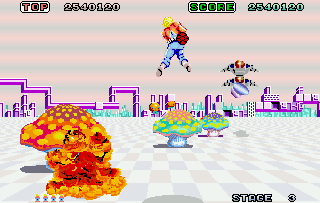 Until the release of Sega Ages on the Saturn (and later Shenmue 1 & 2), the 32X version of Space Harrier was the best one available and the closest to being arcade perfect. Sega’s classic shmup is famous for its frantic pace and twitch gameplay, and all of this is intact here. The graphics are better than any other rendition (surprise!), and it plays as smooth as butter with the wonderful Genesis D pad. True, when I want to play Space Harrier today, I whip out my Saturn Mission Stick and my copy of Sega Ages, but the 32X is a great alternative for those poor souls who don’t have Sega’s 32-bit machine. The 32X’s meager sound chip doesn’t exactly do Space Harrier’s unforgettable soundtrack justice, but I suppose it’s forgivable. This was the type of game the 32X needed, but Sega of Japan was in a corporate daze. It took them another two generations to realize that pretty 3D graphics aren’t enough for a game to be successful. Gameplay is what counts, and Space Harrier has that in spades. That’s the reason it’s a classic, and that’s why it’s been released so many times, most recently on the Sega Classics Collection.
Until the release of Sega Ages on the Saturn (and later Shenmue 1 & 2), the 32X version of Space Harrier was the best one available and the closest to being arcade perfect. Sega’s classic shmup is famous for its frantic pace and twitch gameplay, and all of this is intact here. The graphics are better than any other rendition (surprise!), and it plays as smooth as butter with the wonderful Genesis D pad. True, when I want to play Space Harrier today, I whip out my Saturn Mission Stick and my copy of Sega Ages, but the 32X is a great alternative for those poor souls who don’t have Sega’s 32-bit machine. The 32X’s meager sound chip doesn’t exactly do Space Harrier’s unforgettable soundtrack justice, but I suppose it’s forgivable. This was the type of game the 32X needed, but Sega of Japan was in a corporate daze. It took them another two generations to realize that pretty 3D graphics aren’t enough for a game to be successful. Gameplay is what counts, and Space Harrier has that in spades. That’s the reason it’s a classic, and that’s why it’s been released so many times, most recently on the Sega Classics Collection.
After the incredible game that was the original Space Harrier, it would seem that Sega would be hard pressed to come up with a sequel that could uphold that standard. Some might say that Space Harrier II comes up short, but I would have to disagree. Yes, it’s not as long as the original. Yes, it’s also easier. Does that make it a bad game? Hardly. The sequel stays true to the original formula and goes a step further by adding boss battles at the end of each stage. The scrolling is pretty smooth for a Genesis launch title, and no one would ever think by looking at it that the system could only display 64 colors onscreen at one time.
FACT: Even though the original was ported to just about every console under the sun, no other systems got Space Harrier II except the Commodore 64 and the Sinclair ZX Spectrum.
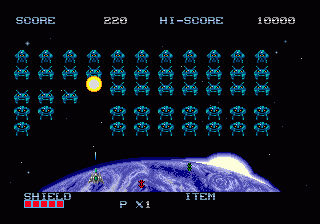 Timeless. That’s about as good a word as any to describe Space Invaders. Along with other arcade icons, like Pong and Pac-Man, it always manages to find its way back into arcades and homes. Just about every console ever made got a port of it in some fashion, and the Genesis received a version of the updated arcade game, which sported new aliens, power ups (speed boost, finally!), and even scrolling backgrounds; all the while maintaining the tried-and-true gameplay of the original. You also have a shield, which helps against the new boss battles that have been added. The gameplay has been refined, and your ship now has a much faster rate of fire, which makes all the difference in the world. Set against some cool backdrops, Space Invaders ’91 is a great little game for when you need a change of pace. Be sure to snatch a copy up quickly though; its price on eBay is increasing at a steady rate and it’ll soon be among the more expensive shmups to find.
Timeless. That’s about as good a word as any to describe Space Invaders. Along with other arcade icons, like Pong and Pac-Man, it always manages to find its way back into arcades and homes. Just about every console ever made got a port of it in some fashion, and the Genesis received a version of the updated arcade game, which sported new aliens, power ups (speed boost, finally!), and even scrolling backgrounds; all the while maintaining the tried-and-true gameplay of the original. You also have a shield, which helps against the new boss battles that have been added. The gameplay has been refined, and your ship now has a much faster rate of fire, which makes all the difference in the world. Set against some cool backdrops, Space Invaders ’91 is a great little game for when you need a change of pace. Be sure to snatch a copy up quickly though; its price on eBay is increasing at a steady rate and it’ll soon be among the more expensive shmups to find.
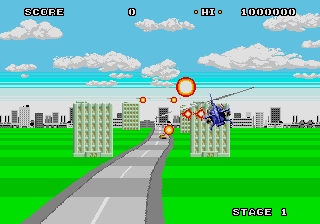 Here we go! One of the first shmups available on the Genesis and based on the awesome (for the time) arcade game, Super Thunder Blade is a sequel to the coin op that made an appearance on the Sega Master System. It tries to improve on the original, but the graphical upgrades done to the scaling make the gameplay less fluid and as hard on the eyes as Sega’s 8-bit machine ever could. Moreover, it’s a bit on the short side, and there’s little fun to be had here, and I guarantee you’ll be pulling your hair on level five. The night city stage was simply a bit too much for the Genesis to handle so early in its life span, and those darn bars that cross the screen aren’t really visible until they’re practically on top of you. Luckily, your chopper is somewhat maneuverable. A decent soundtrack and some boss battles that never capitalized on their full potential round out the package, making this a questionable purchase for shmup fans. Even so, I really think it’s time this series made a comeback, even if it were on a second volume of Sega Arcade Classics. Please Sega, listen to the fans for once!
Here we go! One of the first shmups available on the Genesis and based on the awesome (for the time) arcade game, Super Thunder Blade is a sequel to the coin op that made an appearance on the Sega Master System. It tries to improve on the original, but the graphical upgrades done to the scaling make the gameplay less fluid and as hard on the eyes as Sega’s 8-bit machine ever could. Moreover, it’s a bit on the short side, and there’s little fun to be had here, and I guarantee you’ll be pulling your hair on level five. The night city stage was simply a bit too much for the Genesis to handle so early in its life span, and those darn bars that cross the screen aren’t really visible until they’re practically on top of you. Luckily, your chopper is somewhat maneuverable. A decent soundtrack and some boss battles that never capitalized on their full potential round out the package, making this a questionable purchase for shmup fans. Even so, I really think it’s time this series made a comeback, even if it were on a second volume of Sega Arcade Classics. Please Sega, listen to the fans for once!
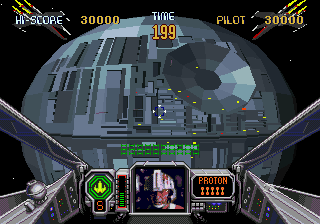 Probably the best reason to own a 32X (yes, there actually are a couple), Star Wars Arcade was the game that single handedly saved Sega in Christmas 1995, keeping Nintendo’s Donkey Kong Country from running away with the market. A port of the great Model 1 arcade game, it brought the best battle of the trilogy to the small screen in a way not seen since the original Star Wars: The Arcade Game had done so over a decade before. Sega improved on the original by adding a special 32X mode, which extended the game by an additional four levels. I personally hate timed levels, and it can sometimes be a pain to have your time run out when you only need one or two more TIEs to kill. It may not be as attractive today as it was back in ’95, but the gameplay is still there, and it’s still fun to play. It’s also incredibly common, and you can practically get a copy just by asking for one.
Probably the best reason to own a 32X (yes, there actually are a couple), Star Wars Arcade was the game that single handedly saved Sega in Christmas 1995, keeping Nintendo’s Donkey Kong Country from running away with the market. A port of the great Model 1 arcade game, it brought the best battle of the trilogy to the small screen in a way not seen since the original Star Wars: The Arcade Game had done so over a decade before. Sega improved on the original by adding a special 32X mode, which extended the game by an additional four levels. I personally hate timed levels, and it can sometimes be a pain to have your time run out when you only need one or two more TIEs to kill. It may not be as attractive today as it was back in ’95, but the gameplay is still there, and it’s still fun to play. It’s also incredibly common, and you can practically get a copy just by asking for one.
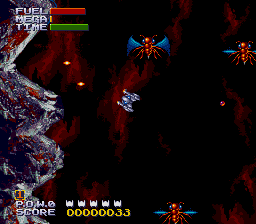 I have mixed feelings writing about this one. Sub-Terrania is one of those games you love to hate. The steep learning curve will shy away all but the most dedicated gamers but once you learn how to navigate your craft, the game isn’t so bad. Fighting gravity might not be something everyone wants to do but it changes the whole shmup dynamic dramatically. Unfortunately, it doesn’t always change it for the better. Navigating through narrow openings can be a pain and the lack of a decent HUD (where’s my shield?) can lead to many bouts of “why did I just die?”
I have mixed feelings writing about this one. Sub-Terrania is one of those games you love to hate. The steep learning curve will shy away all but the most dedicated gamers but once you learn how to navigate your craft, the game isn’t so bad. Fighting gravity might not be something everyone wants to do but it changes the whole shmup dynamic dramatically. Unfortunately, it doesn’t always change it for the better. Navigating through narrow openings can be a pain and the lack of a decent HUD (where’s my shield?) can lead to many bouts of “why did I just die?”
The whole concept of rescuing humans and maintaining your fuel supply is cool enough (the story cut scenes are excellent) but the overbearing gameplay gets in the way far too much. It’s sad really, as I honestly wanted to like Sub-Terrania. Read the review.
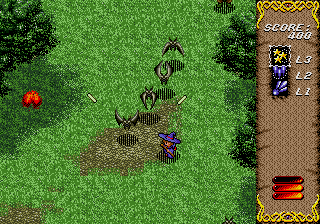 If you can say that Undead Line plays like Commando, then that has to go double for Twinkle Tale. It starts out playing like a vertical shmup and then allows you to walk freely horizontally! Levels stretch out in all directions and while you follow a set path, you can maneuver all over the screen. Some, like stage three, are somewhat interactive (you walk on a cliff from which you can fall, losing a bar of energy). I was initially taken in by its easy-to-learn gameplay and soon found that although it has nothing really innovative about it, it was a joy to play. The single life you’re given adds some challenge and there are several weapons to choose from (including a neat homing shot). Decent graphics and sound may not sound like much at first look but give it a chance and it’ll grow on you. I’m currently searching for a copy and hopefully I’ll be able to get one without having to pawn a kidney.
If you can say that Undead Line plays like Commando, then that has to go double for Twinkle Tale. It starts out playing like a vertical shmup and then allows you to walk freely horizontally! Levels stretch out in all directions and while you follow a set path, you can maneuver all over the screen. Some, like stage three, are somewhat interactive (you walk on a cliff from which you can fall, losing a bar of energy). I was initially taken in by its easy-to-learn gameplay and soon found that although it has nothing really innovative about it, it was a joy to play. The single life you’re given adds some challenge and there are several weapons to choose from (including a neat homing shot). Decent graphics and sound may not sound like much at first look but give it a chance and it’ll grow on you. I’m currently searching for a copy and hopefully I’ll be able to get one without having to pawn a kidney.
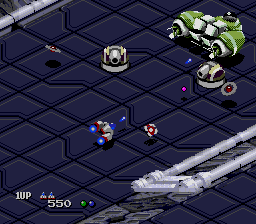 SNK’s Viewpoint pays homage to the classic Sega arcade game Zaxxon by using the same perspective. The gameplay, however, is quite different. It was originally released in arcades on the powerful MVS Neo Geo hardware, and this port is obviously scaled down to fit on the Genesis. The only problem is that it’s still more than the hardware can handle in some instances, and the amount of slowdown that plagues it can hamper the gameplay significantly. It fares much better than the SNES version (blech!) and is still playable.
SNK’s Viewpoint pays homage to the classic Sega arcade game Zaxxon by using the same perspective. The gameplay, however, is quite different. It was originally released in arcades on the powerful MVS Neo Geo hardware, and this port is obviously scaled down to fit on the Genesis. The only problem is that it’s still more than the hardware can handle in some instances, and the amount of slowdown that plagues it can hamper the gameplay significantly. It fares much better than the SNES version (blech!) and is still playable.
The inhabitants of an alien world plan to wipe out all life on Earth (big surprise) and you are our only hope! Your ship has a charge beam in addition to its standard shot, and it can hold up to three different bomb power ups, which you will definitely need. This game is HARD, and the slowdown doesn’t help, like it should. The high point here is how well Viewpoint looks in s-video. Everything is crystal clear and sharper than virtually anything I’ve seen on the system. Too bad the gameplay isn’t as good.
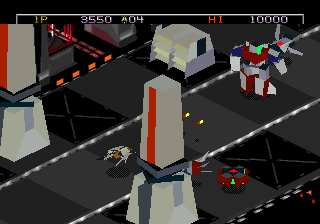 When I think of Zaxxon, I think of how badly I want another sequel. Motherbase 2000 was a great answer to my prayers, albeit one on the wrong platform. Flat-shaded polygons may have been something to marvel at in 1995, but like Silpheed, they haven’t aged all that well. The 32X’s sound chip doesn’t help matters much but the sound isn’t as bad as in some other games on the system. Honestly, I’d be happy if someone took this game and rereleased it as part of a collection (toss in the original Zaxxon while you’re at it), and that would give gamers a chance to see how cool it really is. The coin-op classic’s great gameplay has been updated with some nifty features, like being able to “hack” an enemy ship and use it against its own forces. Many people weren’t aware of this little detail and promptly dismissed Zaxxon as more fodder on an already doomed console. When you take advantage of the hacking dynamic, the game really is a blast to play. Everything, even the plot, is straight forward. If you’re looking for another title for your minuscule 32X collection, give Zaxxon’s Motherbase 2000 a try.
When I think of Zaxxon, I think of how badly I want another sequel. Motherbase 2000 was a great answer to my prayers, albeit one on the wrong platform. Flat-shaded polygons may have been something to marvel at in 1995, but like Silpheed, they haven’t aged all that well. The 32X’s sound chip doesn’t help matters much but the sound isn’t as bad as in some other games on the system. Honestly, I’d be happy if someone took this game and rereleased it as part of a collection (toss in the original Zaxxon while you’re at it), and that would give gamers a chance to see how cool it really is. The coin-op classic’s great gameplay has been updated with some nifty features, like being able to “hack” an enemy ship and use it against its own forces. Many people weren’t aware of this little detail and promptly dismissed Zaxxon as more fodder on an already doomed console. When you take advantage of the hacking dynamic, the game really is a blast to play. Everything, even the plot, is straight forward. If you’re looking for another title for your minuscule 32X collection, give Zaxxon’s Motherbase 2000 a try.
Too many Shmups!
So there you have it, every shmup ever made for the Genesis, Sega CD, and 32X. All of these systems are just laden with quality shmups and every person who’s a fan of the genre should check out. Some of the Japanese games go for much more but are also worthy purchases. Whichever type you prefer: horizontal, vertical, or otherwise, there’s something here for everyone.



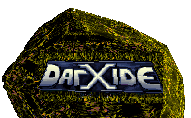
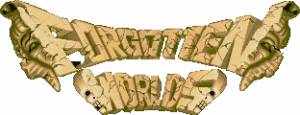
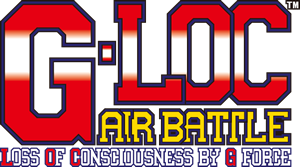
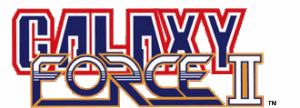











Recent Comments